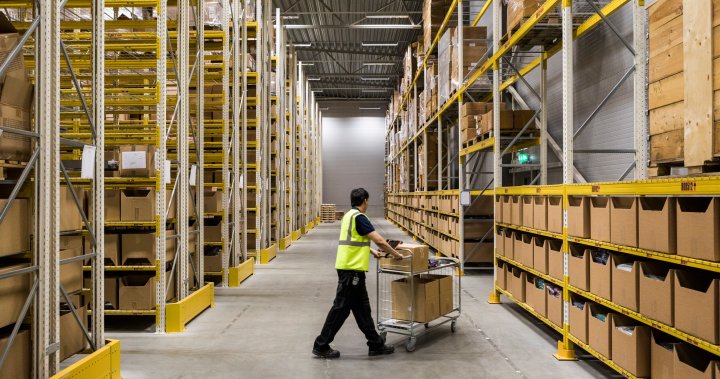Stay home.
This has been one of the driving messages we’ve heard throughout the pandemic to combat the spread of COVID-19.
Last week, the Ontario government’s stay-at-home order came into effect and the province entered its second state of emergency.
“By doing the right thing and staying home, you can stay safe and save lives,” Premier Doug Ford said at a press conference at Queen’s Park.
READ MORE: Coronavirus: Ontario government’s stay-at-home order now in effect
It seems simple enough, but experts say when you take into account the hundreds of thousands of essential workers in health-care, transportation and other industries, staying home may not be an option.
Dr. Sumon Chakrabarti, an infectious disease physician based in Mississauga, Ont., says the “stay at home” messaging overlooks the realities of many workers in marginalized communities.
“These are people that are working in these really essential jobs. And what are they hearing over and over again? They’re hearing ‘stay home’. They can’t stay home,” he said.

Chakrabarti says though restrictions are necessary when it comes to limiting the spread of COVID-19, the notion of staying at home has been “beaten like a dead horse,” and people have become numb to it.
“Many workers go to work feeling unwell (when quite contagious) because the alternative is being off for several days and potentially not having money to pay for essentials,” Chakrabarti recently wrote in a Twitter thread.
READ MORE: Lack of sick leave fueling coronavirus transmission in Canada: advocates
One of these people who can’t stay home is Jason, an Amazon warehouse worker based in Tsawwassen, B.C.
Global News has chosen to hide his full identity due to privacy reasons.
Living with both his parents — who are both at high risk of getting infected — he is terrified at the thought of giving them COVID-19.
The alternative, however, would mean unemployment.
“If I were to catch [COVID-19] and get infected, I doubt they’d survive … but I don’t know what else to do,” he said.
WATCH: Confusion over Ontario’s new stay-at-home order
[ Sign up for our Health IQ newsletter for the latest coronavirus updates ]
For Selena, a daycare worker in Edmonton, staying home would mean a loss of income.
Global News has chosen to hide her full identity due to privacy reasons.
She says she is scared to tell management if she has mild COVID-19 symptoms because this would mean she would have to isolate for 14 days and lose pay.
Since the pandemic started, she says the daycare has had seven positive cases when the facility closed to contain the spread, it was mandatory for all of the workers to use their paid sick leave.

When the facility reopened, Selena had no paid sick days left.
“It’s not our fault this is happening. It’s unfair that they’re finding ways to reduce our benefits rather than helping us,” she said.
READ: More COVID-19 rules? Experts say ‘band-aid solutions’ won’t deal with the source
According to the Decent Work and Health Network (DWHN), 58 per cent of workers in Canada don’t have access to paid sick leave. For low-income workers, that number is 70 per cent.
Carolina Jimenez, a registered nurse in Toronto and coordinator for DWHN, says the absence of paid sick leave is “frustrating” because it affects her ability to provide care to patients.

“Income is one of the most important social determinants of health,” she said, adding that a guaranteed income would mean her patients would be able to follow her advice and public safety measures.
“So the real problem here is that precarious work is a health hazard.”
She points to the example of long-term care workers, who have been hit especially hard by the pandemic.
“A lot of workers in that sector, uncoincidentally, are Black and racialized women workers in extremely precarious situations in the sense that they have to work multiple jobs without adequate benefits like paid sick days,” Jimenez said.
“A stay-at-home order does nothing to support a low wage worker.”
WATCH: Coronavirus: Questions and Answers on Ontario’s stay-at-home order
It’s exactly this link between income and health that spurred Toronto’s medical officer of health, Dr. Eileen de Villa, to recently issue a report calling for the Ontario government to provide 10 days of paid sick leave for workers amid the pandemic.
Ford confirmed last week there are no plans to introduce paid sick leave.
He referred to the support as a “duplicate” of the Canada Recovery Sickness Benefit (CRSB) currently offered by the federal government.
The CRBS offers $500 per week — for a maximum of two weeks — to people unable to work at least 50 per cent of their scheduled workweek due to COVID-19-related isolation or sickness.

Unlike paid sick days — which would be an automatic income replacement if legislated — people would have to apply for the CRBS the week after they were sick and lost their income.
Even then, they might not meet all the criteria.
For full-time workers who do qualify for the benefit, it amounts to $12.50 per hour before taxes.
READ: Additional paid sick leave, eviction ban left out of Ontario’s latest coronavirus restrictions
Deena Ladd, the executive director of the Workers Action Centre based in Toronto says the program has too many barriers for workers — especially for people who don’t have immigration status.
She adds that the CRBS is an insufficient replacement for guaranteed paid sick leave.
“When they wake up in the morning, they need to make a decision if they’re not feeling well — about whether or not they’re gonna go to work,” Ladd said.
“You can’t make that choice … the decision around not being able to look after your family and put food on the table is not a choice, right?”
READ MORE: Ontario attempts to clarify what is essential under COVID-19 pandemic stay-at-home order
Ladd says we need to start paying serious attention to labour standards before we can contain the spread of COVID-19.
”When the politicians and these public health officials are just saying this one message (stay home), it is disregarding the hundreds and thousands of workers that it doesn’t apply to.”
© 2021 Global News, a division of Corus Entertainment Inc.


